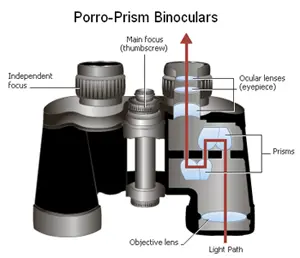The Binocular Site
The Inner Workings of Binoculars
 Binoculars come with a wide range of features. Each uses lenses and prisms in slightly different ways, and choosing carefully can mean the difference between an excellent experience and a blurry image.
Binoculars come with a wide range of features. Each uses lenses and prisms in slightly different ways, and choosing carefully can mean the difference between an excellent experience and a blurry image.
Galilean binoculars are the simplest, and each use four lenses – two convex and two concave. Although these lenses automatically provide an upright image, only low magnification is possible, along with a very narrow view. Therefore this design is only used for inexpensive binoculars along with opera and theater glasses.
More modern binoculars are designed using prisms in conjunction with lenses. In this case the lenses offer a better field of view and higher magnification, but result in an upside down image. Consequently prisms are used to set the image upright again for viewing.
Porro prism binoculars are created by placing prisms in a double Z-shape. This prism placement requires more area, resulting in wider binoculars, and allowing for bigger lenses and thus, better light collection. After time the prisms may need to be re-calibrated to ensure they work effectively, however this design is less expensive than Roof prism binoculars, and more popular.

Roof prism binoculars are created by using shallow, small prisms and result in more compact binoculars. Their smaller size makes them a more durable option for hunting or as a spare pair to stay in your glove compartment. They can also be lighter in weight and easier to hold for long periods. Consider them when optimum quality is needed along with easy carrying.
Roof prisms are collimated more tightly and securely when they are produced, so they tend to take rougher handling better without the need to be recalibrated. However, these prisms require special coatings to use light effectively, including phase coating, aluminum coating, silver coating, and dielectric coating.
What do all those numbers mean?
Ultimately Porro prisms and Roof prisms can offer comparable images. In fact, the following details define quality for both types of binoculars.
Magnification and Objective Lens Diameter:
These are always described together using a pair of numbers such as “7x50”. When described this way, the first number refers to the magnification amount, and the second to the diameter of the objective lens. For example, “7x50” means that images are magnified 7x, and the objective lenses have a diameter of 50mm. These measurements are of greatest importance to image quality so need to be considered carefully.
Higher magnification will allow you to see objects further away, but will narrow your field of view. So you’ll see further, but for objects close to you, you’ll be restricted to looking at a smaller area and refocusing if that object is moving. A lower magnification from about 7x to 10x is fine most of the time, whereas magnifications of 20x to 30x are necessary for astronomy.
Larger lens diameter allows more light to enter the binoculars and reach your eye. While they increase weight significantly, bigger lenses are best for night-time viewing, hunting at dusk or dawn when game move, and even low-light environments such as heavily wooded forests.
Field of View (FOV):
Refers to the area visible to you as you use your binoculars. The number given tells you how big an area you can see when viewing objects 1000 yards away. For example, a FOV of 372 ft. means you will see an area of 372 ft. 1000 yards away from you. Wide angle lenses are available to increase that FOV for game hunters and sports fanatics.
Eye Relief:
This is the minimum distance at which you must hold the eyepieces away from you. This is important especially for those who wear eyeglasses, so make sure to test this in store to find a set of binoculars that are comfortable for you to hold to your eyes.
Exit Pupil:
Is the virtual opening at the center of each lens through which light can move on its journey through the binoculars. Optimally this exit pupil needs to closely match your own pupil, as light that travels outside yours is lost. Therefore this becomes important when you use binoculars at night – your pupils dilate to take in more light, so a bigger exit pupil of about 7mm is ideal for astronomy. However, during the day your pupil will be about 2.5mm.
Calculate the exit pupil by dividing lens diameter by magnification – so binoculars at 7x50 have a lens pupil of about 7mm and are good at night. Binoculars at 20x50 not only offer more magnification but a smaller exit pupil of 2.5mm which is ideal for bright daylight use.
What are coated lenses?
Anti-reflective coatings can make a huge difference in image quality by preserving light as it moves through the binoculars and to your eyes. Magnesium fluoride is most commonly used for either prism type, and binoculars maybe listed anywhere from coated (at least one surface is coated with anti-reflective material) through multi-coated (two or more surfaces are coated) and on to fully multi-coated.
Other coatings such as phase coating, aluminum coating, silver coating, and dielectric coating are required for Roof prism binoculars.

